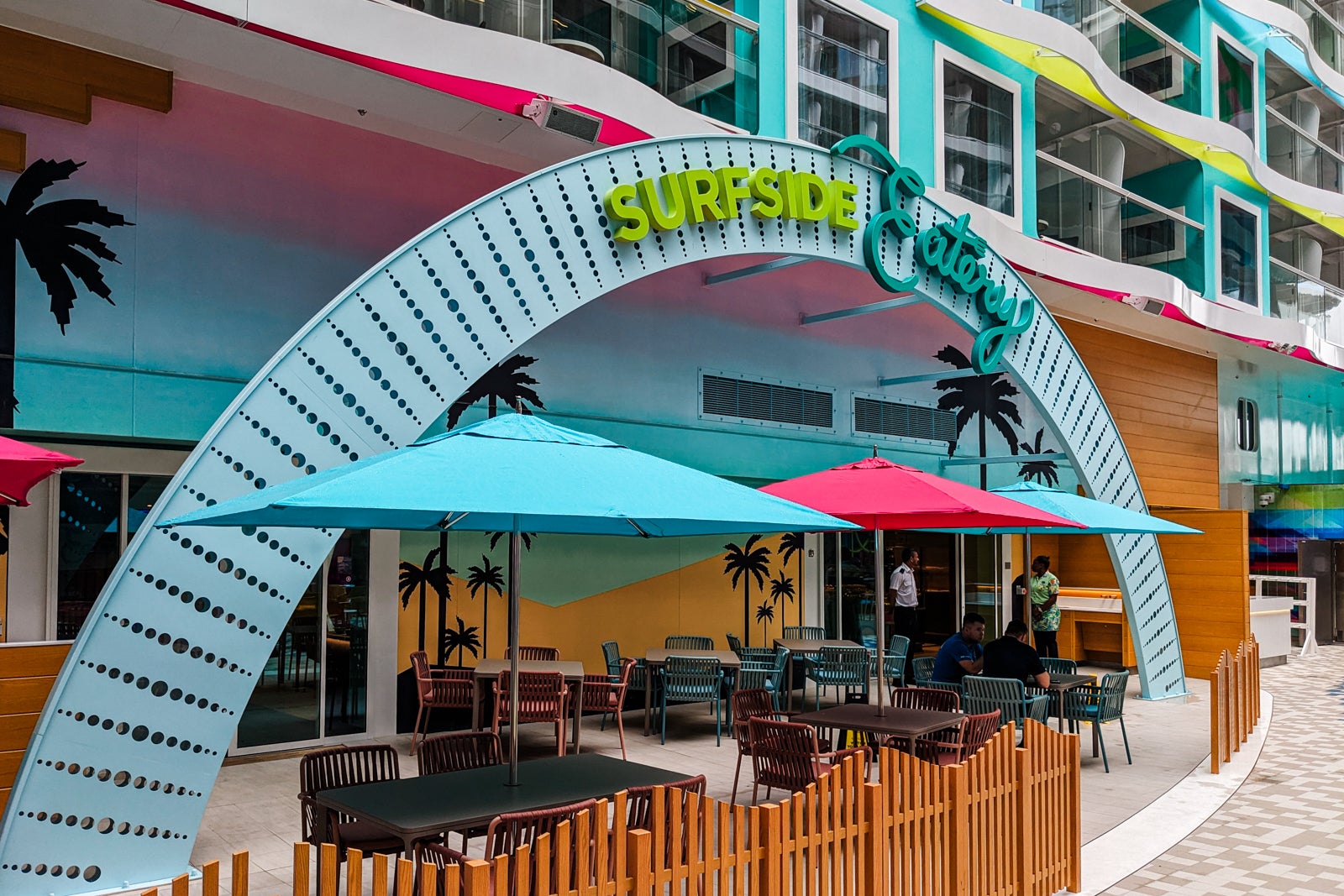There’s one thing that can make or break a cruise ship experience, and it’s not dining, entertainment or cabins.
It’s flow.
I’m talking about passenger flow, the ability of guests to move through a cruise ship unimpeded by crowded bottlenecks or dead ends. And when you’re building Icon of the Seas, the world’s largest cruise ship, set to carry 5,610 passengers at double occupancy (up to 7,600 at maximum capacity), you need to pay extra attention to where people will congregate and how they will move from point A to point B throughout a 20-deck-high ship.
For cruise news, reviews and tips, sign up for TPG’s cruise newsletter.
Luckily, Royal Caribbean’s ship-designing team are pros when it comes to flow.
The internet has been freaking out about the size of the ship, and the assumption of many people who have never sailed on a giant cruise ship is that thousands of people stuck together on a floating megaresort will lead to the feeling of people everywhere. They imagine a vacation that is dominated by queues, claustrophobic spaces packed with people and the inability to find a quiet spot to yourself.
While certain parts of the ship will be busy (the pool deck on a sea day is never quiet on big, mass-market ships), Icon of the Seas passengers will not feel like they’re fighting for seats, tables and clear pathways every minute of the day. The ship is designed to move passengers easily through the decks, connecting key public areas and removing dead ends.
“We had to go to great lengths to make it feel like there was not too much, or that when you put 7,000 guests on there that it was going to feel overwhelming,” Jay Schneider, Royal Caribbean’s chief product innovation officer, told TPG during an interview aboard Icon of the Seas. “And that took us to some really specific decisions.”
Here’s what he told us about what his team did to create a humongous cruise ship that won’t feel as crowded as you fear.
Daily Newsletter
Reward your inbox with the TPG Daily newsletter
Join over 700,000 readers for breaking news, in-depth guides and exclusive deals from TPG’s experts
Guest flow
Schneider and his team make a point to study other cruise ships, both Royal Caribbean and its competitors. “Where I think ships often feel stuffy, tight, closed is guest flow,” he said.
“Cruise ships continue to find dead ends for people that they can’t get around, and we really focused on not doing that [on Icon of the Seas]. You can get from Deck 2 to Deck 8 at the heart of the ship without having to touch an elevator if you don’t want to.”
I experienced that easy flow on board Icon of the Seas during a sneak peek at the ship this week in advance of its first sailings (though it only had hundreds, not thousands, of people on board). When you’re in Surfside, the ship’s family area, it’s simple to go up the stairs to Central Park, an outdoor park-line zone of the ship, or down to the indoor, mall-like Royal Promenade. You don’t feel lost because the neighborhoods are distinct, and you can easily move between them.
To assist with guest flow, Icon of the Seas offers multiple options to move between decks in key neighborhoods. Multiple stairways in the Royal Promenade let you switch decks at multiple places, not just at either end. In two places on the ship — going down into Surfside from Deck 8 and between two levels of the Chill Island pool deck — you can slide between decks.
Related: Royal Caribbean ships ranked by size from biggest to smallest — the complete list
Icon of the Seas also sports a new elevator system, where instead of getting into any available elevator and selecting a floor once inside, you use a touchpad to select your floor and then are directed to one of 12 elevators in the lobby. The amount of research that went into this plan is mind-boggling.
Schneider sent team members to observe people using this new elevator technology in high-rise office buildings and on other cruise ships that employed it. Then, they ran their own tests.
“We built out a replica of the lift lobby on Symphony of the Seas,” Schneider said. “We ran live guests through two different simulations. One sailing we adjusted and then came back months later with a new one. We got a couple hundred guests to run through because the elevators play a key role in that flow. That was where technology comes in to help make that purposeful for us.”
The team saw that though the technology was not intuitive to many guests, it made a huge difference. Ultimately, “we went with it because the flow is so important.”
But, again, the line is being smart about how to make getting around the ship seamless. “We’re going to have greeters on Deck 5, 6 and the Windjammer” on the first day of the cruise, Schneider explained. “We’re going to have somebody explain to you on day one what it is because we learned in our testing that after day one, everybody’s got it and we didn’t want to put that cognitive overhead [to figure out the new system] on the guest.”
As a side note, one of the obstacles to smooth flow on cruise ships is often teens congregating in the stairwell. We spoke to members of Royal Caribbean’s product team who told us how they held many focus groups with teens to figure out the best way to provide hangouts and activities that they would be more likely to attend to get them into specific areas of the ship and out of the elevator stairwell.
The upshot is that more teen activities will take place around the ship instead of in the teen lounge, with takeovers of adult-only spaces like the Hideaway or a teen teppanyaki dinner in Izumi.
Related: The ultimate guide to Royal Caribbean cruise ships and itineraries
Opening up the Royal Promenade
The Royal Promenade is the main thoroughfare of the public areas through many of Royal Caribbean’s larger ships. The indoor area often feels like a mall, with storefronts and restaurants lining an artificially lit corridor with no windows. Your first step onto the ship is often into this buzzy yet chaotic space, and the effect can be overwhelming. On Oasis-class ships with two-deck-high Promenades, the upper deck dead-ends before it reaches the opposite side of the ship.
On Icon, Royal Caribbean set out to open up the Royal Promenade to make it lighter and more spacious and improve the feeling and flow. Schneider said there were three main factors that led to the success of the space.
The first is the Pearl, a spherical structure in the center of the Promenade with a staircase inside. It looks like an art installation, but actually, it’s the structural support of the ship. It replaces the steel skeleton that holds up most ships in that area and takes the burden, so the center of the ship on both sides can be lined with windows looking out to the sea. The effect brings more light into the space to eliminate that dark mall feeling.
The second was the removal of cabins from above the Royal Promenade. “You don’t find for the first time on any Royal Promenade any staterooms,” said Schneider. “And that’s how we get a full 360 mezzanine and that’s also how we created a more spacious feeling.”
Without interior-facing cabins looking down on the Promenade, Royal Caribbean could repurpose that space to make the upper level extend fully from the front to the stern of the ship. The result is that a person standing in the promenade doesn’t feel so hemmed in by all the cabins looking down, and the passenger flow through the space is assisted because people can go across on two levels, with multiple stairways, as well as the elevator banks on either end, to move between levels.
The last change is that “all of the facades — minus retail that have to be closed — are open.” The Point and Feather pub does not have a wall on its Promenade side but is open to traffic. Giovanni’s, the Italian restaurant, is a fully open space you can walk through on the upper level. Again, that leads to a feeling of openness and lets people move freely between walkways and venues without creating bottlenecks at doorways.
Related: The 5 best destinations you can visit on a Royal Caribbean cruise
Self-contained neighborhoods
Schneider didn’t mention Icon’s neighborhood concept in relation to guest flow, but Linken d’Souza, Royal Caribbean’s vice president of food and beverage, gave us some insight into how Icon of the Seas was designed with ease and convenience in mind.
“With all of the neighborhoods, we thought about how do you make it convenient,” he told us. That means that in the major neighborhoods of the ship, guests will find food options, so they don’t have to leave and descend on the Windjammer Marketplace buffet with everyone else. They can find options where they are.
For example, at Surfside, the neighborhood geared to young families, you’ll find three restaurants: the Surfside Eatery buffet, Surfside Bites for grab-and-go kid fare and Pier 7, a casual specialty restaurant where kids eat free, but parents can enjoy elevated lunch and dinner offerings. No one has to trek across the ship when hunger strikes.
The Thrill Island neighborhood that houses all the adrenaline-spiking offerings (a water park, a ropes course, a rock-climbing wall) has Basecamp serving comfort food like burgers and chicken sandwiches, and the AquaDome has the AquaDome Market, a five-venue food hall, and the Hooked Seafood specialty restaurant.
By giving guests reasons to linger in one place, you have fewer people constantly traversing the ships and crowding elevators and corridors.
Related: 35 Royal Caribbean cruise tips and tricks that will make your voyage better
He also spoke about new dining reservation technology that Royal Caribbean is working on to make it easier to get into the restaurants you want when you’re fighting for space with 7,000 shipmates. Of course, multiple dining venues, including additional complimentary ones (based on guest feedback) will hopefully reduce the pressure on specific popular venues.
Additionally, Icon of the Seas will offer five set-seating dining times, as well as My Time Dining, so half the ship won’t descend on the dining room at the same time. It also means passengers will have more choices so they can find the dining time that works best for their family.
Programming will also help to spread people around the ship. The Overlook within the AquaDome is meant to be the quiet spot for reading or hanging out on a sea day when there isn’t an AquaTheater show going on. To create this, the ship won’t schedule popular activities within that area during the day to keep the crowds and noise elsewhere.
Bottom line
When you vacation on the world’s largest cruise ship, you have to be ready for queues and a packed pool deck. But by employing several smart design and programming strategies, Royal Caribbean is striving to eliminate as much of the unnecessary crowding as it can on Icon of the Seas.
I experienced this on Wonder of the Seas (now the second-largest cruise ship in the world); it indeed felt less crowded in places where I encountered bottlenecks or hoards of people on smaller but less-well-designed ships from other lines.
So, don’t be scared of a ship carrying 7,000 people. You’ll be surprised how much your shipmates won’t get in the way of your perfect vacation.
Planning a cruise? Start with these stories:

Jessica Roberts is a seasoned business writer who deciphers the intricacies of the corporate world. With a focus on finance and entrepreneurship, she provides readers with valuable insights into market trends, startup innovations, and economic developments.






:max_bytes(150000):strip_icc():focal(749x0:751x2)/common-tiffany-haddish-jennifer-hudson-050924-2-59ceaa8897334ff19da3ffcbea0049b7.jpg)


